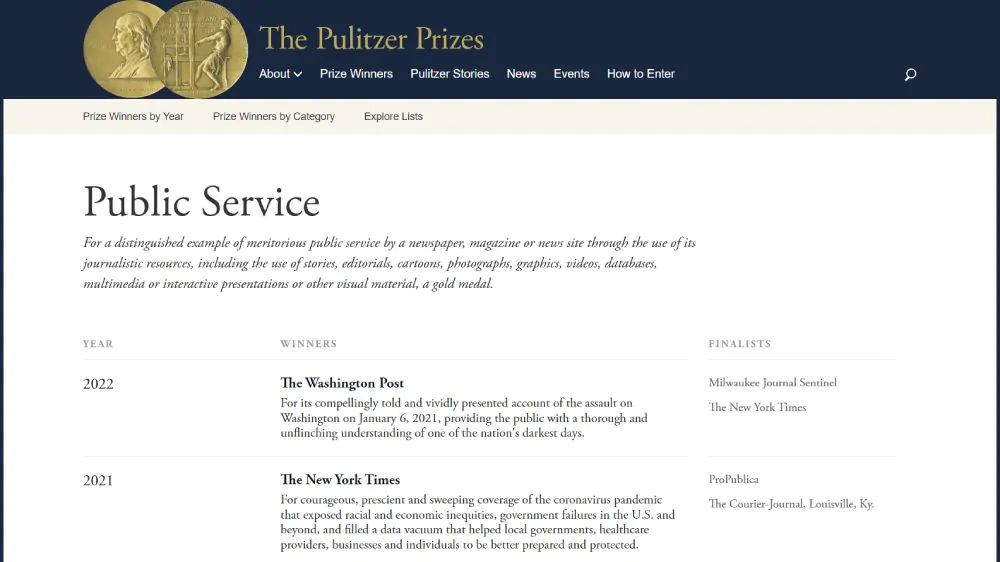Discover what is public service journalism and how writers can try this essential form of media for themselves in our tell-all guide.
Public service journalism is the independent, ethical, and accurate reporting of issues of common concern to the public. This type of journalism distributes information that allows an informed public to participate in a democratic society supported by unbiased media.
In short, the answer to ‘what is public service journalism’ lies within its name: public service journalism is a type of journalism designed to service the general public’s information needs and society as a whole.
Contents
What Is The Purpose of Public Journalism?

One of the primary purposes of independent public service journalism is to ensure that those in positions of power are held accountable. This was a point made by former UK Member of Parliament, Ruth Smeeth, in her editorial article ‘The Value Of Public Service Journalism.’
In this article, she discusses the difference between nations with independent public service journalism and states with more restricted media. She used the example of the BBC covering the story of a protester who claimed to be dragged into the China consulate in Manchester, England. Here, Smeeth claims, is a story that would not be published in countries that restrict their public service journalism.
“We have seen the value of public service journalism. In Manchester, the BBC documented a democracy protester being dragged into the Chinese consulate by CCP officials. He was beaten. His story is now known and the subject of a diplomatic incident because the BBC covered the news… his story was told by independent journalists.
Contrast that with events in Russia. Protest is banned. Independent journalism is all but crushed. Dissidents are arrested every day. Challenge is not tolerated. Their leaders never questioned.”
Ruth Smeeth
Public service journalism also enacts positive change. This is a point made by the non-profit media organization, PublicSource. It states that “public service journalism is the bedrock of our democracy because it challenges the status quo and (it) inspires change for the better.” Despite public service journalism ethos being for non-bias, independent journalism, there are still detractors.
A report published by the Reuters Institute for the Study of Journalism found that brands that conduct public service roles within media are often less trusted by “people on the political right and by people with populist attitudes.”
Logic dictates that these people look for their information from other sources if they don’t trust public service journalism. These sources often include social media timelines and video hosting platforms. Here, these people could receive information that is not designed to inform but rather to create divisive discourse.
Thus, one of the newer roles of this type of media is to build trust in public service journalism by reporting on meaningful stories that rise above digital noise. This was also touched upon by PublicSource, who added: “Public-service journalism is the type of journalism that believes the mission is to serve the public with meaningful stories, not clickbait.” You might be interested in our post about how a third of UK librarians are asked to remove or censor books.
The Pressure of Public Service Journalism
Public service journalism is an integral part of the media and is why many professional reporters pursued their interest in the profession in the first place. It is also a type of reporting that carries a weight of responsibility.
This pressure is understandable, as public service journalism is one of the key elements to building a working democratic society. As a legendary broadcaster, Walter Cronkite, once said: “Journalism is what we need to make democracy work.”
This was a point that was also touched upon by the European Broadcasting Union when they said that “public service journalism, through its commitment to independent, impartial, accurate and relevant news, is key to building informed societies and strong democracies in an era of digital noise, disruption, disinformation, and political pressures.”
Renowned Irish journalist Katie Gannon (much of whose work could be deemed public service journalism) discussed some of these pressures when she said that “(as a public service journalist), you have to work hard not to let people down.”
If you feel inspired by the idea of public service journalism and feel up to the task, you might want to read our guide on ‘Is Journalism a Good Career?’.
Public Service Journalism Examples

The value of this type of journalism is evident when you consider that The Pulitzer Prize for Public Service Journalism was one of the original Pultizer awards. It is considered the most prestigious Pulitzer and is the only one where the winner is given a gold medal.
The Pulitzer for Public Service was first announced in 1917 and awarded in 1918. According to their website, it is awarded “for a distinguished example of meritorious public service by a newspaper, magazine or news site through the use of its journalistic resources, including the use of stories, editorials, cartoons, photographs, graphics, videos, databases, multimedia or interactive presentations or other visual material.”
The first winner of the Pulitzer Prize for Public Service was The New York Times for their reporting on World War I. This was due to the official reports, documents, and speeches relating to the war that the New York Times published.
The latest winner was the aforementioned Washington Post for their compelling account of the January 6th attacks on Washington. In their report entitled ‘The Attack,’ The Post detailed the before, during, and after of the violent attack on the Capitol building in 2021.
Other notable recipients include The Boston Globe for their coverage of sexual abuse by priests in the Roman Catholic Church and the Fort Worth (TX) Star-Telegram. The latter’s reporting revealed that nearly 250 U.S. servicemen had lost their lives due to a design problem in helicopters built by Bell Helicopter.
Both are worthy examples, as the former led to massive changes within the Roman Catholic Church. It brought influential people to account for their behavior and became one of the most powerful pieces of public service journalism. Meanwhile, the latter brought about change in military equipment, proving that public service journalism can make a real change in the day-to-day lives of its readers and within society.
Difference Between Public Service Media and Public Service Journalism
Although similar and often confused, public service media (PSM) and public service journalism are different. The former refers to media that is funded by the public for the public. It can include various platforms, with journalism representing one element rather than its whole.
This difference can be identified in the key remit for PSM, defined by the world’s most famous PSM provider, the BBC, in the 1920s. They said that the remit of public service media is to inform, educate, and entertain.
Of course, journalism can take on elements of all three. However, it’s easy to see how public service media, such as the BBC, answers the above remit with more than just its journalistic output.
The BBC produces public service media, with their reporters often producing public service journalism. Their public service media can also include entertainment and educational content that has little to do with journalism. However, the likes of The Washington Post, for example, produce public service journalism with the goal of informing the public rather than entertaining them.If you like this article, check out our guide to the best journalism tools.